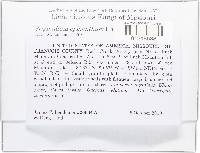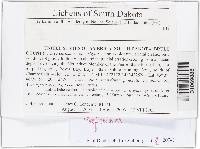
Consortium of Lichen Herbaria
- building a Global Consortium of Bryophytes and Lichens as keystones of cryptobiotic communities -
- Home
- Search
- Images
- Species Checklists
- US States: O-Z >
- US National Parks
- Central America
- South America
- US National Parks
- Southern Subpolar Region
|
|
|
|
Family: Mycosphaerellaceae
|
Nash, T.H., Ryan, B.D., Gries, C., Bungartz, F., (eds.) 2004. Lichen Flora of the Greater Sonoran Desert Region. Vol 2. Vegetative hyphae: hyaline, hardly discernible in thallus sections Pseudothecia: black, globose to obpyriform, sessile, 100-140 µm high and 120-180 µm wide wall: consisting of 2 layers, the outer layer dark brown, entirely carbonized, inner layer basally hyaline to pale brown hamathecium: with pseudoparaphyses of type a asci: clavate to saccate, 40-60 x 12-15 µm, 8-spored, with ocular chamber; endoascus: I -and KI -, BCr- ascospores: hyaline, 1-septate, not constricted at the septa, upper cell slightly thicker than lower one, ellipsoid , 11-17 x 5-7 µm; walls: smooth, thin, BCr- Pycnidia: not seen. Hosts: thallus areolae or sometimes on apothecial discs of Acarospora subg. Xanthothallia, incl. A. heufleriana, A. lavicola, A. radicata, A. schleicheri and A. xanthophana World distribution: Africa, Australia, and North and South America Sonoran distribution: known from many localities in Arizona and southern California, Baja California, and Baja California Sur, Chihuahua, Sinaloa and Sonora. Notes: There are at least three species of Stigmidium s. l. occurring on Acarospora: S. epixanthum, S. fuscatae (see below) and S. rouxianum Calat. & Triebel (see Calatayud and Triebel [2003]). The ascomata of S. epixanthum are mostly sessile, are often found scattered or in irregularly small groups, preferring the edges and fissures of the yellow thallus areoles. |
Powered by Symbiota












